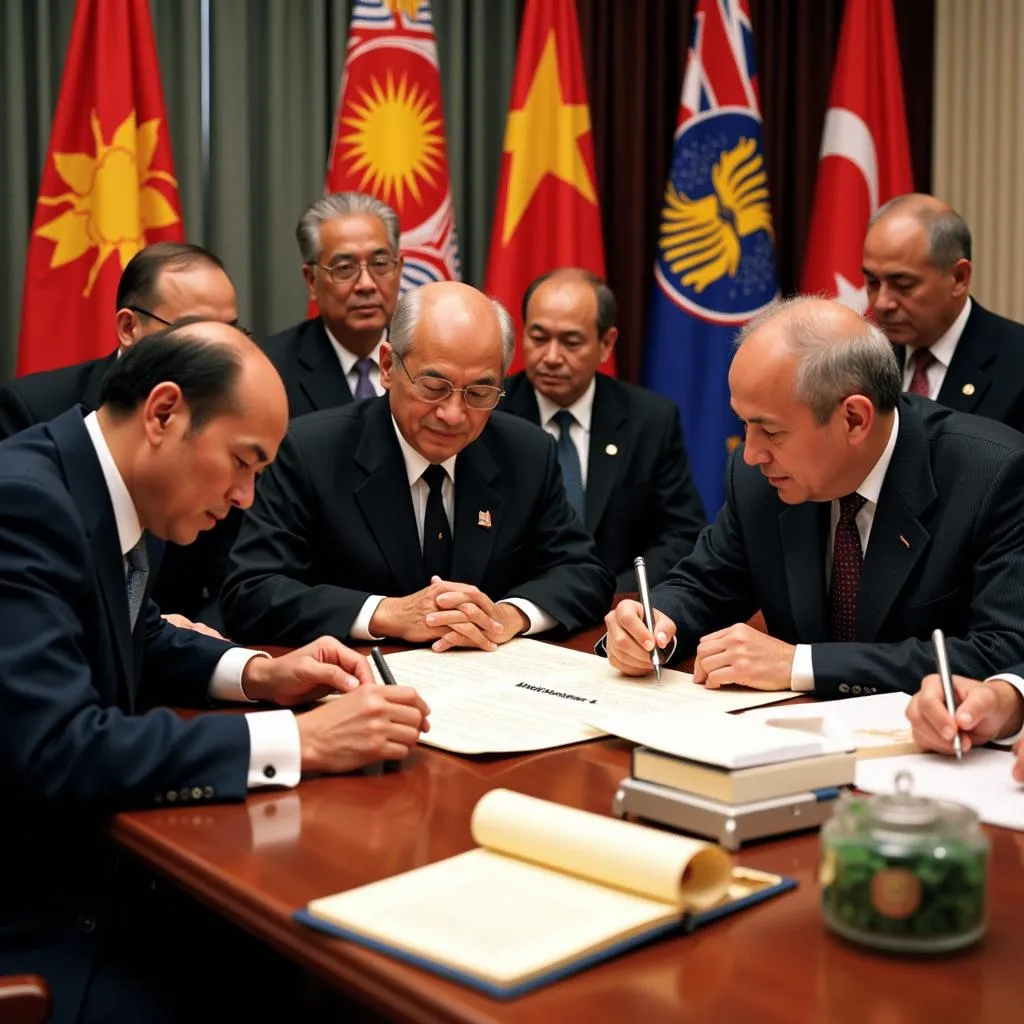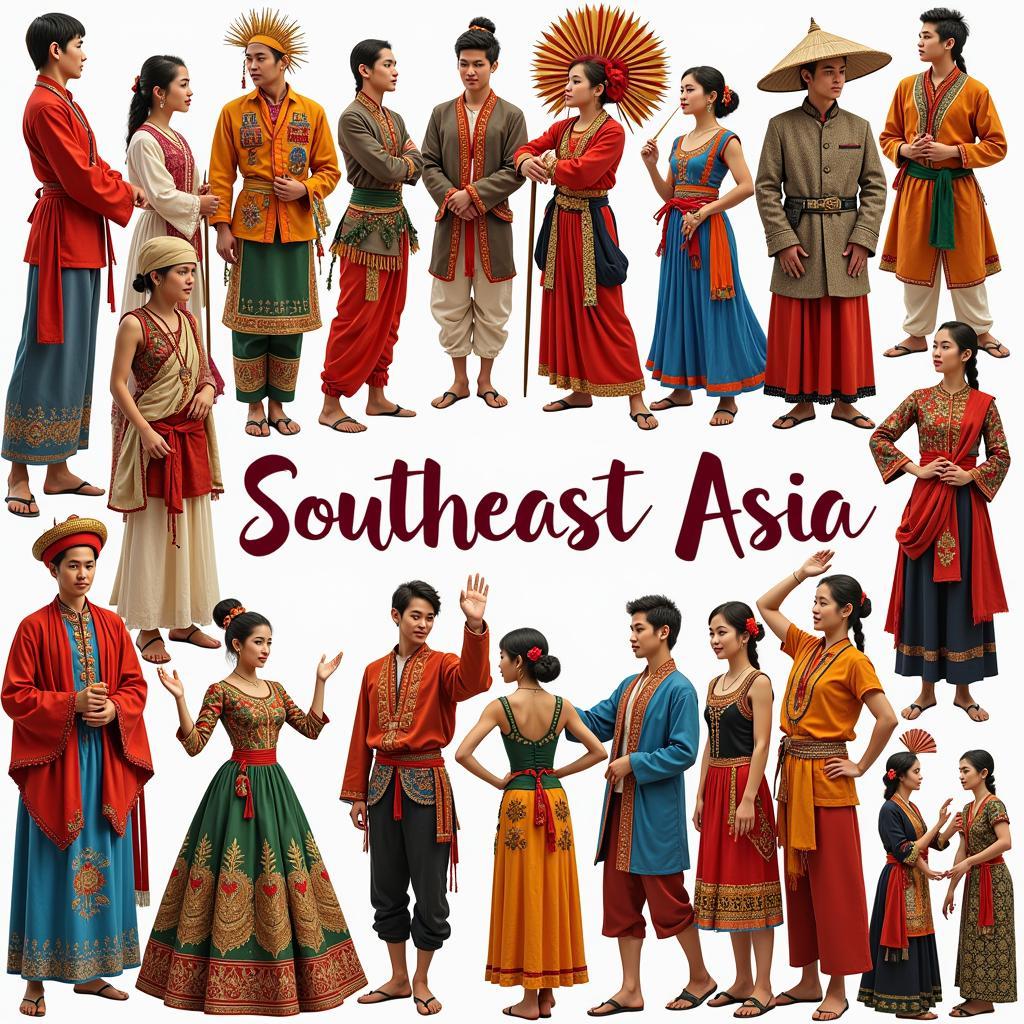The term “ASEAN” is frequently encountered in global dialogues, representing a dynamic region brimming with diversity and potential. But what exactly is the root definition of ASEAN? What are its foundational pillars, and how do they shape the aspirations and identity of Southeast Asia? This exploration delves into the core of ASEAN, uncovering its historical context, key principles, and enduring impact on the region and the world.
Delving into the Genesis of ASEAN: A Need for Unity and Progress
 Founding Fathers of ASEAN
Founding Fathers of ASEAN
The ASEAN root definition lies in its historical context. Born in 1967 amidst a turbulent period marked by Cold War tensions and regional instability, the Association of Southeast Asian Nations (ASEAN) emerged from the collective vision of five founding nations: Indonesia, Malaysia, the Philippines, Singapore, and Thailand. These nations recognized the need to foster unity and cooperation to address common challenges and chart a course towards lasting peace and prosperity. The signing of the Bangkok Declaration on 8 August 1967 marked the formal establishment of ASEAN, laying the groundwork for a regional organization that would transform Southeast Asia.
Pillars of ASEAN: Guiding Principles for Cooperation and Integration
At the heart of the ASEAN root definition are its fundamental principles, which serve as the bedrock for regional cooperation and integration. These principles, enshrined in the ASEAN Charter, guide the organization’s endeavors and shape its interactions on the global stage. Let’s delve into the key tenets that underpin ASEAN’s existence:
- Mutual respect for the independence, sovereignty, equality, territorial integrity, and national identity of all nations: This principle underscores the importance of respecting the diverse political systems, cultures, and values of each member state, fostering an environment of trust and understanding.
- The right of every State to lead its national existence free from external interference, subversion or coercion: ASEAN champions the principles of non-interference in the internal affairs of member states, advocating for peaceful resolution of disputes and upholding the sovereignty of nations.
- Renunciation of the threat or use of force: Committed to peaceful coexistence, ASEAN promotes dialogue and diplomacy as the primary means of resolving conflicts, rejecting the use of force or aggression in inter-state relations.
- Effective cooperation among themselves: Recognizing the interconnectedness of regional challenges, ASEAN encourages collaboration in areas of shared interest, such as economic development, security, and socio-cultural exchange.
- Settlement of differences or disputes by peaceful means: ASEAN emphasizes dialogue, consultation, and mediation as the preferred approaches to resolving disagreements, fostering a culture of peaceful settlement and preventing escalation of conflicts.
ASEAN’s Enduring Legacy: A Catalyst for Regional Transformation
 ASEAN Economic Growth Chart
ASEAN Economic Growth Chart
Over the past five decades, ASEAN has evolved from a nascent organization into a driving force for regional integration and development. The organization has played a pivotal role in:
- Maintaining peace and stability: ASEAN’s commitment to dialogue and cooperation has contributed significantly to the long-lasting peace and stability enjoyed by the region, creating a conducive environment for economic growth and social progress.
- Promoting economic integration: Through initiatives like the ASEAN Free Trade Area (AFTA) and the ASEAN Economic Community (AEC), the organization has fostered greater economic integration, boosting trade, investment, and economic growth among member states.
- Enhancing regional connectivity: Recognizing the importance of seamless connectivity, ASEAN has prioritized infrastructure development, transportation links, and digital integration to facilitate the free flow of goods, services, and people across the region.
- Addressing transnational challenges: From climate change and natural disasters to terrorism and cybercrime, ASEAN has demonstrated its commitment to tackling shared challenges collectively, fostering regional resilience and security.
- Amplifying Southeast Asia’s voice on the global stage: As a united front, ASEAN plays an increasingly influential role in global affairs, engaging in constructive dialogue and cooperation with its international partners to address global issues.
Looking Ahead: ASEAN’s Vision for a Shared Future
As ASEAN navigates the complexities of a rapidly evolving global landscape, the organization remains steadfast in its pursuit of a shared vision: to build a peaceful, stable, prosperous, and integrated Southeast Asian community. This vision is articulated in the ASEAN Community Vision 2025, which outlines key aspirations for the region, including:
- A highly integrated and cohesive economy: ASEAN aims to further deepen economic integration, promote innovation, and enhance competitiveness to position the region as a global economic powerhouse.
- A resilient and innovative society: Recognizing the importance of human capital development, ASEAN is committed to fostering a knowledge-based society, empowering its people with the skills and opportunities to thrive in the digital age.
- A sustainable and secure community: ASEAN strives to address environmental challenges, promote sustainable development, and enhance regional security to ensure the well-being of its people and the preservation of its rich natural heritage.
FAQs: Unraveling Common Queries about ASEAN
1. What is the primary purpose of ASEAN?
At its core, ASEAN seeks to promote peace, stability, and prosperity in Southeast Asia through dialogue, cooperation, and integration.
2. How many countries are currently members of ASEAN?
ASEAN comprises ten member states: Brunei Darussalam, Cambodia, Indonesia, Lao PDR, Malaysia, Myanmar, the Philippines, Singapore, Thailand, and Viet Nam.
3. What are some of ASEAN’s notable achievements?
ASEAN has played a pivotal role in maintaining regional peace, promoting economic integration, fostering cultural exchange, and enhancing regional connectivity.
4. How does ASEAN engage with the international community?
ASEAN actively engages with dialogue partners, regional organizations, and international institutions to address global issues and foster cooperation.
5. What is the significance of the ASEAN Charter?
The ASEAN Charter, adopted in 2007, provides a legal and institutional framework for the organization, outlining its principles, objectives, and mechanisms for cooperation.
Exploring Further: Your Gateway to ASEAN Insights
- Discover the latest news and updates on ASEAN’s initiatives and achievements on our website.
- Delve deeper into the rich tapestry of ASEAN’s culture, history, and people through our captivating articles and multimedia resources.
- Connect with our team of experts to explore partnership opportunities, access valuable insights, and stay informed about ASEAN’s dynamic landscape.
Ready to Connect with ASEAN? We’re Here to Help
For any inquiries or assistance related to ASEAN, don’t hesitate to contact our dedicated team. You can reach us at:
Phone Number: 0369020373
Email: aseanmediadirectory@gmail.com
Address: Thon Ngoc Lien, Hiep Hoa, Bac Giang, Viet Nam.
Our customer support team is available 24/7 to assist you with any questions or concerns you may have.
